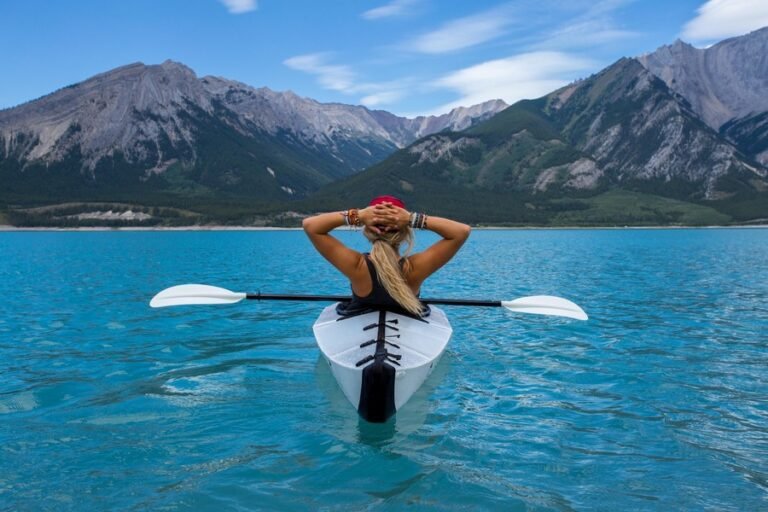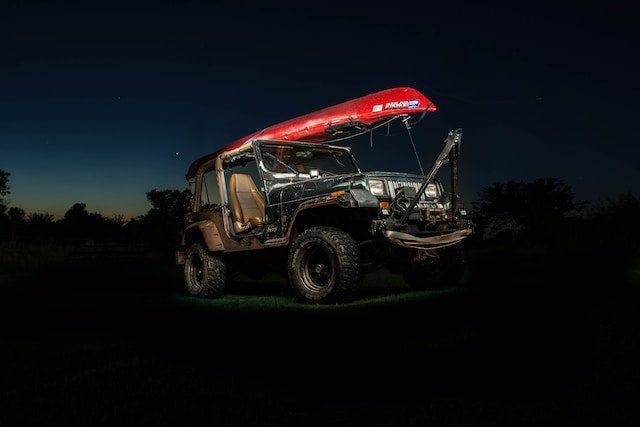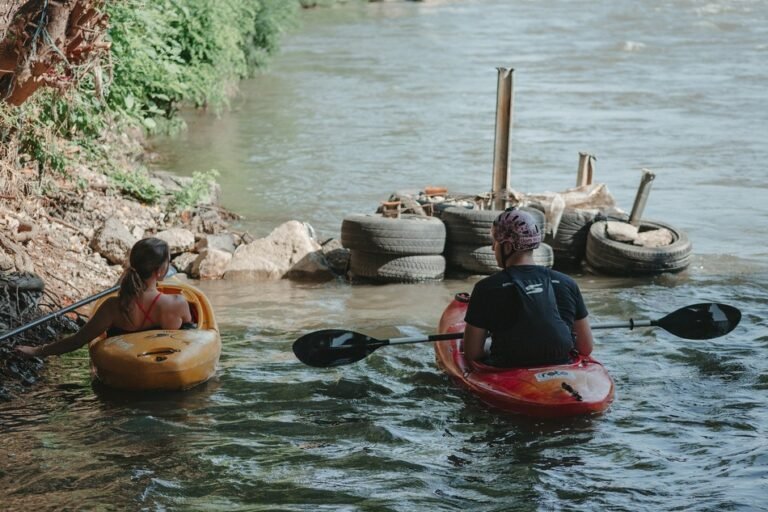How To Get Into Whitewater Kayaking

Kayaking is a sport that involves paddling a kayak across a body of water. There are different types of kayaks, including touring kayaks and recreational kayaks.
Touring kayaks are designed for longer trips, while recreational kayaks are designed for shorter trips around the lake or river. Kayakers can also choose to paddle with a single or double-bladed paddle.
Kayakers can use different strokes to move through the water, including the forward and backward stroke, the sweep stroke, and the sculling stroke. Kayaking can be done in calm or rough waters and can be enjoyed by people of all ages and fitness levels.
Whitewater kayaking is a form of this famous sport that involves kayaking in fast, shallow stretches of water in a river or turbulent waters.
What Is Whitewater Kayaking?
Whitewater kayaking is one of the most popular leisure activities in North America. It combines the excitement and challenge of rafting with the agility and power of kayaking, making it one of the most challenging and rewarding activities you can do in nature.
Whitewater kayaking can be done on a wide variety of rivers and streams, from Class I to V. The sport involves paddling down a river or stream in a kayak, sometimes with Class I-IV rapids or even Class V or VI rapids.
There are many different types of whitewater kayaks, from simple solo kayaks to multi-person kayaks designed for professional whitewater rafting trips. The thrill of the rapids is only part of the experience; the scenery and serenity of wild rivers are also amazing.
The purpose of whitewater kayaking is to have fun and challenge yourself while experiencing the natural beauty of the rivers and streams. Kayaking is great for fitness, relaxation, and exploring new surroundings.
Why Do People Engage In It?
Whitewater kayaking is an increasingly popular sport that offers a lot of fun and excitement for people of all ages.
There are many reasons why people engage in whitewater kayaking, but some of the most common reasons include the exhilaration of feeling the river current through the watercraft, the challenge of navigating through tricky sections, and the camaraderie that comes with participating in a group activity.
Whitewater kayakers must be able to handle a lot of physical activity and also have good balance and coordination. The scenery on a whitewater river can be breathtaking, and the feeling of being in control while kayaking is exhilarating.
Kayakers use the power of the river to chase down waves and perform tricks. The exhilaration of whitewater kayaking is unmatched, and it’s a great way to get exercise and have fun.
Whitewater Kayaking Gear
Whitewater kayaking is a great way to explore the river and see some of its hidden beauty. The equipment needed for this activity is not too expensive, but it does require a few key pieces. Here are the items you’ll need:
- A kayak. There are many different types of kayaks available, so find one that is comfortable for you.
- A paddle. A good paddling style depends on the type of kayak you’re using, so find a paddle that fits your needs.
- Kayak accessories. These include items such as a spray skirt, a hat, and a life jacket.
- A dry bag for your gear.
- Sturdy shoes
- A helmet
- Sunblock and bug repellent to prepare for an outdoor adventure!
Having the right gear is essential for not just fun but a safe whitewater kayaking trip. Ensure you take these with you and know how to use them to be safe on your exhilarating journey.
How To Get Into Whitewater Kayaking
Whitewater kayaking is a great way to get outside and have some fun. There are many places to kayak in the US and even more around the world. If you are interested in getting into whitewater kayaking, here are some tips on how to get started.
1. It’s always a good idea to sample anything you wish to try before investing in it, and whitewater kayaking is no different. Before going all out and getting your own kayak and gear, you want to be sure this sport is as rewarding as it seems.
If you have been kayaking, this is probably a new step in your adventures, and with a little guidance, you should be fine. If you are just getting into kayaking, however, you want to do things right.
2. A crucial step is getting an instructor. Someone who is proficient at the sport and can put you through. It is also a good idea to go kayaking with this person a few times till you are sure you’ve mastered the basics and can handle yourself safely on the water.
Your instructor will help you refine your paddling technique and other such things to help you negotiate those rapids. It is also a good idea to practice in calm waters before going to the dangerous ones.
3. Rent accessories for your first few trips. It might be cheaper to get some if you are part of a paddling club. The aim of this phase is to sample this exhilarating sport and decide if it is for you.
While whitewater kayaking is undeniably fun, some people are not built for the thrills are rapids it brings, so finding out if the sport is for you before buying gear of your own is a smart idea. If you cannot bring yourself to enjoy the sport, don’t feel bad.
There are several other sports out there, and the aim is to have fun while staying fit. It is very likely, however, that whitewater will prove itself and you will enjoy yourself.
4. Find a place to kayak. As Rome was not built in a day, you won’t immediately become proficient at your newfound sport; that might take a while.
You should find a good place with beautiful scenery where you can practice till you master the sport. Kayaking in a known environment allows you to become confident in your skills and ensure you are safety-aware.
Start with flatwater and kayaking in a straight line. Gradually increase the level of challenge you face in the sport with our level of growth. This ensures you are never faced with risks you can’t handle and that you progress while having fun.
If you don’t get it straight away, be patient. Consistency and hard work will pay off in time, and you will be navigating those rapids. Once you can handle yourself in calm waters it’s time to hit the hay.
Get someplace with rapid currents to start your whitewater kayaking adventure. Remember to always do so in a controlled environment. Once you reach a satisfactory level of mastery, you can go exploring.
Do not try to explore new places in your whitewater kayaking adventures until you’ve been given a seal of approval by your instructor or other qualified personnel.
While this may seem like a restriction of freedom, it is most necessary for your safety as you might not be advanced enough to handle the challenges of a new environment safely.
5. Once you are skilled enough, it is finally time to leave the controlled environment and embark on exhilarating adventures. Going on this trip alone is greatly discouraged.
You are advised to go with a group of paddlers, preferably with experienced ones among you. The presence of all these paddlers would make you feel safe and comfortable on your adventure. That is good, particularly if you are feeling nervous about your first trip.
Bring extra gear and victuals for your trip. The next step is to enjoy your trip. Be sure to check out those exciting views. You will notice that seeing those things on the water shows them to you in a new light, giving you a new appreciation for nature.
Your sense of time on the water also changes, allowing you to enjoy the beauty even more while still getting the exhilarating feeling of navigating the rapids. At least your subsequent trip should follow the same pattern.
You can gradually reduce your kayaking partners till you are enjoying the sport on your own. Adhere to safety practices and always explore new grounds with caution.
6. At this stage, you are sure without an inkling of doubt that you are into whitewater kayaking. It is finally time to get your gear. You should take all the fun out of this.
Methodically research the available kayaks for your sport and get one that fits your tastes within your budget range. Getting a PFD (Personal Flotation Device), spray skirt, dry bag, helmet, water shoes, and other gear are also recommended.
Having your gear gives you the liberty of hitting the water at will without having to wait for someone or being told when to return the gear. It also allows you to spend as much time on the water as you like.
7. Keep improving your skills. The more you paddle, the better you get at it and the more you get to enjoy those beautiful views of the water while having the exhilarating rush of paddling through rapids.
Never, for any reason, throw caution to the wind on the water. Don’t take unnecessary risks. Remember to be consistent if your efforts are not paying off immediately, and always have fun on the water.
Types Of Whitewater Kayaking
Kayaking is one of the most versatile and enjoyable activities that can be done in nature. It is a great way to get your heart rate up and see some of the most beautiful scenery around.
Whitewater kayaking is an especially thrilling form of kayaking, as it involves navigating rapids on Class III-IV rivers. There are four main types of whitewater kayaking: creek boating, playboating, river running, and downriver racing.
Creek Boating
Whitewater kayaking is one of the most popular forms of outdoor recreation. There are many different types of whitewater kayaking, but some people enjoy creek boating the most.
Creek boating is the easiest form of whitewater kayaking and can be done by anyone who has a kayak and some basic paddling skills.
Creek boating is perfect for beginners who want to experience the thrill of whitewater without having to deal with more difficult rivers. It is a great way to learn how to kayak without risking injury.
Creek kayaking is a unique form of whitewater kayaking that allows you to explore creeks and waterways that you may not be able to access on other types of kayaks. Creeks can be densely forested or filled with gentle riffles, making them perfect for all skill levels.
Playboating
Kayaking is an amazing sport that can be enjoyed by all levels of paddlers. Playboating, a form of whitewater kayaking, is a type of kayaking that is most often done on Class III-IV rivers and streams.
Playboating requires more skill, caution, and coordination than cruising, but it also allows for more fun and excitement. It’s perfect for those who want to experience the thrill of the water but don’t want to get too serious about it.
Playboating often involves playful maneuvers, such as turning and making circles in the water. This type of kayaking is not only a lot of fun, but it can also be a valuable training tool for novice kayakers.
River Running
Whitewater kayaking, or running rapids, is a popular form of recreation that can be enjoyed by anyone of any age. With a little bit of practice, anyone can enjoy this fun activity on both large and small rivers.
River running is perfect for those who want to experience the excitement and adrenaline rush that comes with being in quick-moving water. It’s also an excellent way to improve cardiovascular fitness and muscle conditioning.
Rivers are a great way to see a lot of different scenery in a short amount of time. They’re also a great way to train for whitewater kayaking. There are many different types of rivers to kayak on, so finding the perfect one for you is key.
Some of the best rivers to kayak on are those with Class I-III rapids. Rapids that are class IV or V can be quite dangerous and should only be attempted by experienced kayakers.
If you’re new to river running, start on a slower river. Once you’ve gotten some experience, try out some of the more challenging rivers.
Downriver Racing
Whitewater kayaking is a popular sport that can be enjoyed by people of all ages. Downriver racing, on the other hand, is a more hardcore form of whitewater kayaking that can only be done by experienced kayakers.
Downriver racing is when kayakers navigate their boats down river rapids while competing against one another. Downriver racing involves paddling down a river, usually faster than the flow of the water, in order to beat or chase other paddlers.
It is an intense and exhilarating experience that can only be achieved by those with the proper skills and training. This activity can be both thrilling and dangerous, but it can also be extremely rewarding if you are able to catch and pass other kayakers.
It’s an adrenaline-filled experience that is perfect for those who want to push themselves to their limits.
Tips For Beginner Whitewater Kayakers
Kayaking is a great way to get out and enjoy nature. Whitewater kayaking is a particular type of kayaking that is characterized by its class III-IV rapids.
This type of kayaking is perfect for beginners because it is not as difficult as class V or VI rapids and the scenery is beautiful. Here are five tips for beginners when it comes to white water kayaking:
- Get comfortable in your kayak before starting out. The first step is to get comfortable in your kayak – it’ll make the experience more enjoyable. Make sure you’re seated properly, with your back straight and your feet flat on the floor of the boat.
- Learn to paddle. There’s no better way to learn than by doing. Paddle the kayak through a few small rapids, then move on to something more difficult. Watch videos, ask other paddlers for tips, and practice at home.
- Get a better kayak. If you’re just getting started, you probably don’t want to spend a lot of money on a kayak. Look for one with a narrow beam and high volume, which will make it easier to turn around.
- Learn how to maneuver in the kayak. This doesn’t mean that you need to know a lot of trigonometry, just pay attention to how the watercraft responds to different conditions. You’ll learn a lot more if you take your time than if you rush through it.
- Go with a friend or group of people. It is easier to give up if you are not in a group that is pushing you forward and encouraging you.
- Learn from your mistakes, and don’t give up early!
Kayaking is a great outdoor activity that can provide enjoyment for people of all ages. It is a great way to get exercise and spend time outdoors.
Whitewater kayaking can be a more challenging and adrenaline-pumping experience, but it is important to remember to always practice safety first.
If you are interested in getting into whitewater kayaking, research the best places to paddle and find an experienced instructor who can teach you the basics. Be safe and have fun!






